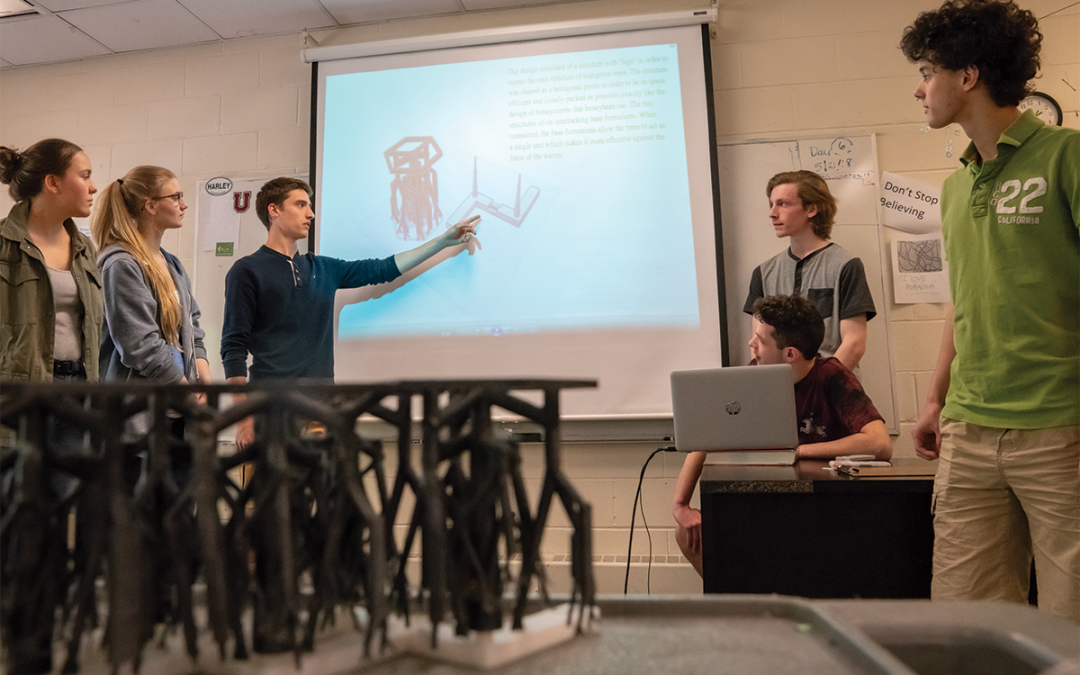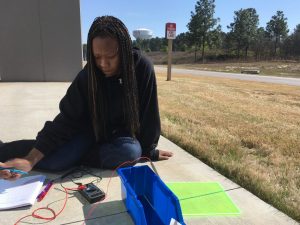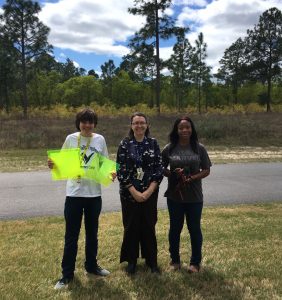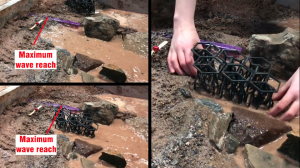By. Gretchen Hooker, Program Manager, Biomimicry Institute
When two students in Kirstin Bullington’s clean energy engineering class decided to take on the challenge of designing a more efficient solar panel, they looked to a seemingly unlikely source for inspiration – the oriental hornet.
These students – both seniors at Richland Two Institute of Innovation, a student innovation center for public high school students in Columbia, South Carolina – were part of the Biomimicry Institute’s Youth Design Challenge (YDC), an education program and design competition that challenges middle and high school students to create solutions to climate change using biomimicry, or nature-inspired design.
After researching a wide range of living organisms, the Richland Two students discovered that the oriental hornet is a marvel of sustainable energy generation. It is able to capture sunlight and, via its outer layer (or epicuticle), convert it into electrical energy. The team first tried to mimic the hornet’s epicuticle color, putting filters over solar panels. This ended up restricting light, so they did more research and shifted gears. Their second approach was to mimic the shingle-like surface texture of the epicuticle to build a solar concentrator. Their design, in addition to their thorough research and testing process, so impressed the YDC judges that they awarded the team first place in the high school competition of the Challenge.
“The first time they tried their [new] prototype, they thought, ‘oh my gosh, it works!’,” said Bullington. “My students blew me away. They always amaze me and come up with better ideas than I could ever come up with.”
Biomimicry is the idea that we can emulate nature’s patterns and strategies to develop sustainable technologies that support healthy people and a healthy planet. Over millennia, living organisms have found ways to heat, cool, move, restore soil, sequester carbon and more, all without burning fossil fuels or using persistent toxic chemicals. By adapting these lessons, innovators are developing better, more regenerative alternatives to the typical “take, make, and waste” approaches to design.
The YDC was created to inspire students – our future innovators and entrepreneurs – to view nature as a model for sustainable design solutions. The program helps middle and high school educators incorporate biomimicry design experiences into their classrooms to support and integrate STEM, environmental literacy, and critical thinking and collaboration skills. The YDC also empowers students (and their teachers) to think differently about nature, engineering, and the future. At a time of grim climate and environmental predictions, the YDC presents a hopeful message that potential solutions are all around us.
The YDC was first pilot tested in Spring 2018 with 54 U.S. middle and high school teachers and more than 600 students – 50% of whom were girls. Feedback was extremely positive from teachers and students, with 93% of students showing a greater interest in nature and sustainability, 87% of students showing improved problem-solving skills, and 84% of students showing greater overall engagement in the learning process after the Challenge. The Institute is now moving forward with plans to expand the program and offer it for a full academic year.
For Laura Norman and Becca Parker, educators at Wilbur Wright Middle School in Munster, Indiana, one of the most valuable aspects of the YDC was the opportunity for students to carry out real-world scientific experiments as they tested their design ideas.
“That was one of the main things we were looking for – a real-world project that incorporated engineering into a semester-long project. This was a really big deal for us,” said Norman. “This kind of program is important for schools and kids to be part of.”
Three of Norman and Parker’s student teams ended up winning prizes or honorable mentions in the Challenge, including a second place win from a team who created a jackrabbit-inspired way to cool computer rooms in buildings without the need for air conditioning.
“I think [the students] felt like they can make a difference. A lot of them were strongly passionate and believed in their idea,” said Parker. “They feel like it’s on their generation to save the world and they’re enthusiastic about it.”
At the Harley School in Rochester, New York, math and science teacher Betsy Vinton said she noticed that her students now show a new appreciation for how nature can inform more sustainable design after participating in the Challenge.
“I teach three students [who participated in last year’s Challenge] now in AP biology and whenever we’re talking about the natural world, they chime in and think about how it can be used to solve a problem,” said Vinton. “They have more awareness of how these natural processes can be harnessed to solve problems. It gives them more of an appreciation of why we need to be better caretakers on the Earth. If we’re going to be looking to nature for solutions, we can’t be ruining the environment.”
Vinton says that the YDC helped her students learn how to take a big problem and break it into manageable pieces. Vinton’s team won third place for a mangrove-inspired solution to coastal erosion resulting from increased storm activity in a changing climate.
“Maybe you can’t solve the big problem all at once, but once you tease it apart, you can find aspects of the problem that you can solve,” said Vinton. “That will serve them well no matter what they do in life.”
Vinton is also working with last year’s participants as they help younger students at the school learn about biomimicry. One of last year’s participants is going to be working with a fourth-grade class to introduce them to biomimicry as part of a capstone course. Plus, the nine students who participated last year are going to help a middle school group with their entries in the middle school contest.
This kind of forward momentum is exactly what the Biomimicry Institute hopes to see as a result of the program. As the YDC grows, more students will learn how to look to nature for sustainable design clues, and see that biomimicry is something they can do, as a career path and a way to make their world better.
“We don’t give youth nearly enough credit that they do care very passionately about things like climate change and what kind of world they’re going to be growing up in,” said Bullington. “And that, given the opportunity to create a design, they can really amaze us.”
You can meet all the winning teams from the 2018 YDC pilot here.
The 2018 – 2019 Challenge is open for registration! To learn more about and register for the Challenge, please visit youthchallenge.biomimicry.org.
Author Bio
Gretchen Hooker is a program manager for the Biomimicry Institute where she oversees the Youth Design Challenge and contributes to many other projects that support biomimicry education. She has a background in sustainable design and holds a master’s degree in industrial design from the Rhode Island School of Design.





